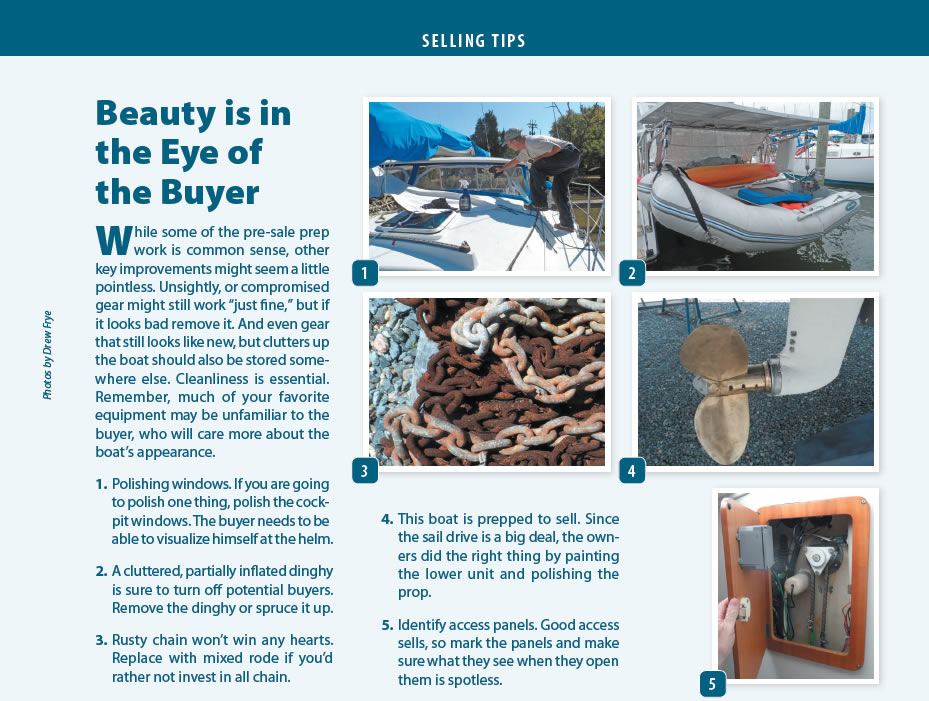
You want to sell your boat. And youd like to sell it quickly. What can you do to make that happen? We recently interviewed several brokers and surveyors for advice on what helps, what hurts, and what flaws are sure to come to light when you are trying to sell your boat. Remember that the savvy buyer will always overemphasize the unknown, believing that for every fault they uncover there are three more lurking, and that these will cost more to set right than you say or they think. Fortunately, a well-maintained boat can often be prepped for sale with a relatively small investment in time and money. And if the boat hasn’t been maintained, youll want to prioritize the tasks required to draw a willing buyer.
Cosmetics
The boat should shine inside and out. Every rust stain, every black heel mark, even the usual waterline stain smile screams poor maintenance. Old stains imply you don’t care. If you don’t have the time or energy to give the boat an inside-out cleaning, contract a detailing company. For an hourly rate, these people will do everything from clean the bilge to compound and wax. The extent of their labor is up to you.
Bilge. Every hidden space should be clean. A dirty bilge is a smelly bilge, and even though you have grown accustomed to your boats odors, the buyer will assume the source is a pervasive mold problem. The surveyor will be crawling in these spaces, and their report will reflect evidence of leaks, mildew, and rot. After cleaning, consider a coat of paint. While youre down there, exercise the seacocks, fix any leaks and replace any rusty hose clamps; the surveyor will test them and he will notice the leaks and clamps.
Windows. If you are going to polish only one thing, make it the ports, windows, and clear vinyl. A good buffing with compound followed by wax can take years off the ports, and a gentle polishing of clear vinyl with a cream protectant (Best Practices for Maintaining Clear Vinyl Windows, Practical Sailor January 2014) will make the sea trial more pleasant.
Clutter. Remove everything, except for items that relate directly to operation of the boat. Much of what you feel has value is just stuff to the buyer and makes the boat look smaller. The buyer needs to visualize the boat as being theirs, and having your stuff everywhere makes that harder.
Anchor and chain. Muddy chains smell and give a bad impression. Pull it all out, wash the locker, rinse it with fresh water as it feeds back in, and dry it with a fan. If it is seriously rusty or if the anchor is bent, pitch it.
Leaks. There can be none. Are there streaks from leaking deck hardware? Dont just wipe up the streaks, re-bed the offending hardware.
Carpet. Dirty carpets smell. Either clean it thoroughly or replace. Inexpensive carpet runners can be cut to shape with scissors and can give a good impression.
Varnish. Refinishing can be a great boost for small dollars.

Life jackets to running Rigging
Pitch your old mildewed life jackets (PFDs) and buy new. This goes for most deteriorated accessories. They don’t add value, they suggest replacement expense, and give the wrong first impression about maintenance. Empty, clean lockers are best.
Safety equipment. Flares and PFDs need to be up-to-date and serviceable. You will need them for the sea trial.
Sails and canvas. Replacing stretched sails is generally too costly, but making minor repairs so they are usable will bring a more favorable survey. Loose threads should be repaired and melted off, battens should all be in place and secured. Slides and slugs should be in good shape-you don’t want the mainsail jamming or breaking during the sea trials. Obvious chafe should be repaired. The sacrificial covers on roller furling sails are an important first impression item. Likewise sail covers; they should be cleaned, repaired, and well-secured. Replace worn furling lines. New buyers often overestimate the cost of these items.
Lines. Scrub on the dock or in a bucket; machine washing should be approached only with great care (Whats the Best Way to Clean Rope? Practical Sailor, July 2011).
Canvas. Repair any worn stitching and patch any holes. Scrub and treat with water repellent (Keeping Canvas in Tip-Top Shape, Practical Sailor, February 2014) to help keep it that way. An anti-mildew treatment (Mildew Treatments and Stain Removers, Practical Sailor November 2013) will also reduce cleaning. Remove any canvas that is not repairable to good condition. Restore or replace cloudy or yellowed vinyl windows as needed.
Systems
You wont sell the boat if the engines don’t start, and even weak batteries can give trouble during sea trials. Old batteries will be noted in the survey, providing an easy starting place for the buyers deduction list.
Does everything work? Remember that for every item that does not work, the buyer will assume there are three faulty systems. If something unnecessary is dead, remove it.
Head. Are the hoses are due for replacement (The Fight Against Head Odors Continues, Practical Sailor, December 2013)? For an honest opinion, ask someone else if the head smells. Does the head itself makes a good impression? Replace the joker valve; few things are as disgusting as a bowl full of flow back, and a fresh valve will eliminate that. Pump and rinse the holding tank, and use a full dose of tank treatment. Leave a dash of treatment in the bowl. If winterized, dash a little concentrate antifreeze in the bowl; the typical -40-degree F burst point juice will mold over time and look disgusting.
Replace the zincs. Zincs are small dollar items and they imply good maintenance.
Dinghy. Make sure it holds air and is clean. If there is an engine, make sure it starts within a few pulls; this may be part of the survey and sea trial. If it belongs on davits, put it there. If you tow it or store it on deck, leave it ashore-ideally somewhere the buyer can inspect it.
Conveyance List. Prepare a complete list of the items that do and do not convey with the sale. In many cases you might have equipment that is part of the sale, but is not kept on the boat: winter covers, de-icers, and spare parts. These should be cleaned, photographed, and placed on the list. There may be items that do not convey which remain on the boat because you are still using it. Every effort should be made to minimize this gear, since even when it is stowed it takes up locker space. Empty lockers sell boats. Our extra gear makes it feel like someone elses home, not theirs.
Equipment and Maintenance Files. Organize these as well as possible, copying tattered sheets and creating and organized binder or file system. Maintenance records, even if you do-it-yourself, paint a picture of an owner who took a consistent interest.
Preparation for Survey
Weve watched the most conscientious owners cleaning and fiddling around fixing little things around the cabin and the deck… and missing the things that matter entirely. We watched a man fuss over a few loose screws in a cup holder for an hour, while ignoring the blisters on the bottom; he didnt do fiberglass.
He didnt see the prop zinc that was so far gone it was missing a bolt. He hadnt considered that these things can be seen from the ground (first impressions) and that they will be on the survey report, accompanied by a nice photo, where they will cause trouble disproportionate to their seriousness.
Traditionally, a survey is commissioned by the buyer after a contract price is set, the function being to disclose items that are not disclosed, evaluate those that are disclosed. Whatever is found becomes a point of negotiation, and you can bet that the surveyor and buyer will be aggressive in assigning dollars to repairs. After all, you had the chance to make repairs and didnt.
For boats of significant value, certainly anything over $50,000, contracting a summary pre-listing survey can be smart money. Small things can be identified and repaired for small dollars, leading to a clean pre-purchase survey. This survey can also be used as a sales tool; be clear with the buyer that they are responsible for their own survey, but show them what was inspected and that deficiencies have been set right.
You can, of course do this yourself. Do you or the broker feel confident that you can inspect and objectively evaluate all of the items that will come up during the pre-purchase survey? There are books, such as Inspecting the Aging Sailboat by Don Casey, but do you have the time, energy, experience, and detachment to both recognize and accept what is important?
Preparations for Sea Trial
Top batteries. Low voltage may be misinterpreted as bad batteries.
Start the engine. Do it the day before. You want no surprises. Check all lights and systems. Make sure all the plumbing lines run without leaks.
Clean the bottom. Either fresh paint or hire a diver. A clean bottom is fast and handles better.
Empty all tanks. Leave enough fuel and water. A lighter boat is faster.
Clear any mess. Stow everything that does not relate to sailing. Keep engine and through hull spaces clear, since the surveyor will likely inspect these while underway.
Other Factors
Location. Boats are more mobile than houses. Dont keep the boat in a deeply rural or run down marina because that will reduce the traffic and lower price expectations. It is easier to be patient if storage costs are low, but maintenance and taxes never stop. You need traffic and a nice background. Consider keeping the boat in a marina proportionate to its value.
Season. People buy all year, but there is no question the peak season is spring, which means getting her ready early. You can do it. Just remember that any task requiring paint or adhesive will be a hold up, and don’t try to bend or polish clear vinyl below 50 F.
Be available. You will almost certainly be present for the sea trials; no one knows the systems and handling as well as you and is more able to make it look easy and pleasant. You can answer questions regarding systems before they become misconceptions. If a broker is engaged, how active you should be in the negotiation and sale should be sorted out ahead of time.
Conclusions
Psychologically youve moved on. Its only natural, but this is also the worst time to lose interest and take your eye off the ball. Look at the boat as you did when preparing to buy, ready to nitpick every flaw and scared that any weakness could imply a money pit. In fact, you are the best and most knowledgeable person to correct any minor flaws and to show her off best. Get it ready for the big dance.

While some of the pre-sale prep work is common sense, other key improvements might seem a little pointless. Unsightly, or compromised gear might still work “just fine,” but if it looks bad remove it. And even gear that still looks like new, but clutters up the boat should also be stored somewhere else. Cleanliness is essential. Remember, much of your favorite equipment may be unfamiliar to the buyer, who will care more about the boat’s appearance.
- Polishing windows. If you are going to polish one thing, polish the cockpit windows. The buyer needs to be able to visualize himself at the helm.
- A cluttered, partially inflated dinghy is sure to turn off potential buyers. Remove the dinghy or spruce it up.
- Rusty chain won’t win any hearts. Replace with mixed rode if you’d rather not invest in all chain.
- This boat is prepped to sell. Since the sail drive is a big deal, the owners did the right thing by painting the lower unit and polishing the prop.
- Identify access panels. Good access sells, so mark the panels and make sure what they see when they open them is spotless.

































